
The Fosse Way was a Roman road in England that linked Exeter in South West England to Lincoln in Lincolnshire, via Ilchester, Bath, Cirencester and Leicester.
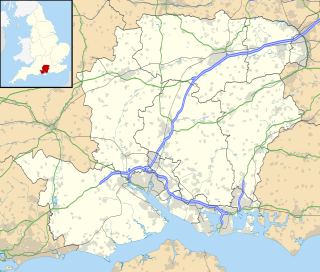
Lovedean is a village in the East Hampshire district of Hampshire, England. It is 1.4 miles (2.2 km) west of Horndean.

Biddlesden is a village and civil parish in Aylesbury Vale district in north-west Buckinghamshire, England on the boundary with Northamptonshire. It is about 5 miles (8.0 km) east-north-east of Brackley, Northamptonshire and 5 miles (8.0 km) north-west of Buckingham. The River Great Ouse forms part of the western boundary of the parish, separating the village from Northamptonshire. The ancient royal forest of Whittlewood extended to the northern edge of the village.
A combe can refer either to a steep, narrow valley, or to a small valley or large hollow on the side of a hill; in any case, it is often understood simply to mean a small valley through which a watercourse does not run. The word "combe" derives from Old English cumb, of the same meaning, and is unrelated to the English word "comb". It derives ultimately from the same Brythonic source as the Welsh cwm, which has the same meaning. Today, the word is used mostly in reference to the combes of southern and southwestern England, of Wales, and of County Kerry in Ireland.
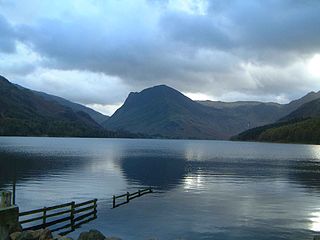
Buttermere is a lake in the English Lake District in North West England. The adjacent village of Buttermere takes its name from the lake. Historically in Cumberland, the lake is now within the county of Cumbria. It is owned by the National Trust, forming part of its Buttermere and Ennerdale property.
Combe may refer to: Valley in old West Country English/Celtic, similar to Welsh equivalent 'cwm'.

Combe Martin is a village, civil parish and former manor on the North Devon coast about 4 miles (6.4 km) east of Ilfracombe. It is a small seaside resort with a sheltered cove on the north-west edge of the Exmoor National Park. Due to the narrowness of the valley, the village consists principally of one single long street which runs 2 miles (3.2 km) between the valley head and the sea. An electoral ward with the village name exists. The ward population at the 2011 census was 3,941.

Michelmersh is a small, scattered village in Hampshire, England some three miles (4.8 km) north of Romsey.

Huish Episcopi is a village and civil parish in Somerset, England, situated on the outskirts of Langport, 4 miles (6.4 km) south west of Somerton in the South Somerset district. The parish has a population of 2,095, and includes the hamlets of Bowdens, Combe, Pibsbury and Wearne.
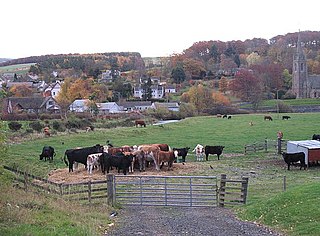
Stow of Wedale, or more often Stow, is a village in the Scottish Borders area of Scotland, seven miles north of Galashiels. In the 2011 Census the population was 718. It is served by Stow railway station.
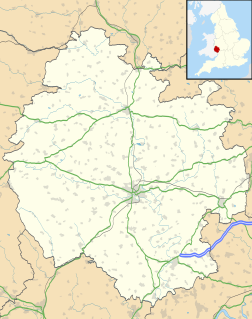
Vowchurch is a village and civil parish in Herefordshire, England, situated in the Golden Valley, on the River Dore. The village is about 10 miles (16 km) southwest of Hereford. According to the 2001 census, the parish had a population of 163, increasing to 176 at the 2011 census.

East Harptree is a village and civil parish in Somerset, England. It is situated 5 miles (8.0 km) north of Wells and 15 miles (24.1 km) south of Bristol, on the northern slope of the Mendip Hills overlooking the Chew Valley. The parish has a population of 644. The parish includes the hamlet of Coley.

Glaramara is a fell in the English Lake District in Cumbria. It is a substantial fell that is part of a long ridge that stretches for over six kilometres from Stonethwaite in Borrowdale up to the important mountain pass of Esk Hause. The summit of Glaramara at 783 m (2,569 ft) is the central point of this ridge, which separates the valleys of Langstrath and Grains Gill. However, the ridge has two additional fells, numerous subsidiary tops and several small tarns making its traverse an appealing and challenging walk.

Tarbolton is a village in South Ayrshire, Scotland. It is near Failford, Mauchline and the same distance bar a few hundreds yards to Ayr and Kilmarnock. The old Fail Monastery was nearby and Robert Burns connections are strong, including the Bachelors' Club museum.
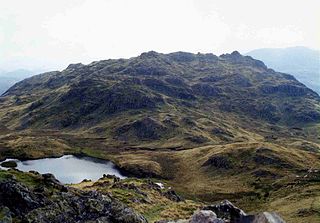
Rosthwaite Fell is a fell in the English Lake District. It is situated some 12 kilometres (7.5 mi) due south of Keswick and 2 kilometres (1.2 mi) south of the village of Rosthwaite in Borrowdale.

Talaton is a village and a civil parish in the English county of Devon. It lies approximately 6 miles to the west of Honiton, 3 miles to the north of Ottery St Mary, 2 miles to the west of Feniton and 2 miles to the east of Whimple. The parish of Talaton covers an area of 965 hectares. Its total population was estimated to be 590 in 2012

Milton Combe is a village in Devon approximately 2 miles from Yelverton and 8 miles from the city of Plymouth. The name Milton Combe is derived from the village's historic name, first mentioned in 1249, of 'Mile Cumbe' literally meaning 'Middle Valley'. The Post Office gave the village its current name in 1890, to distinguish it from the many other 'Miltons' in the nearby area.
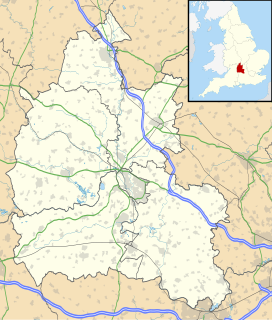
Letcombe Regis is a village and civil parish in the Vale of White Horse. It was part of Berkshire until the 1974 boundary changes transferred the Vale of White Horse to Oxfordshire. The village is on Letcombe Brook at the foot of the Berkshire Downs escarpment about 1 mile (1.6 km) southwest of the market town of Wantage. The 2011 Census recorded the parish population as 578.

Chilson is a hamlet and civil parish in the Evenlode Valley in West Oxfordshire, England, about 4 1⁄2 miles (7 km) south of Chipping Norton. The civil parish also includes the hamlet of Shorthampton, about 2⁄5 mile (1 km) north east of Chilson. The 2011 Census recorded the parish's population as 141.


















